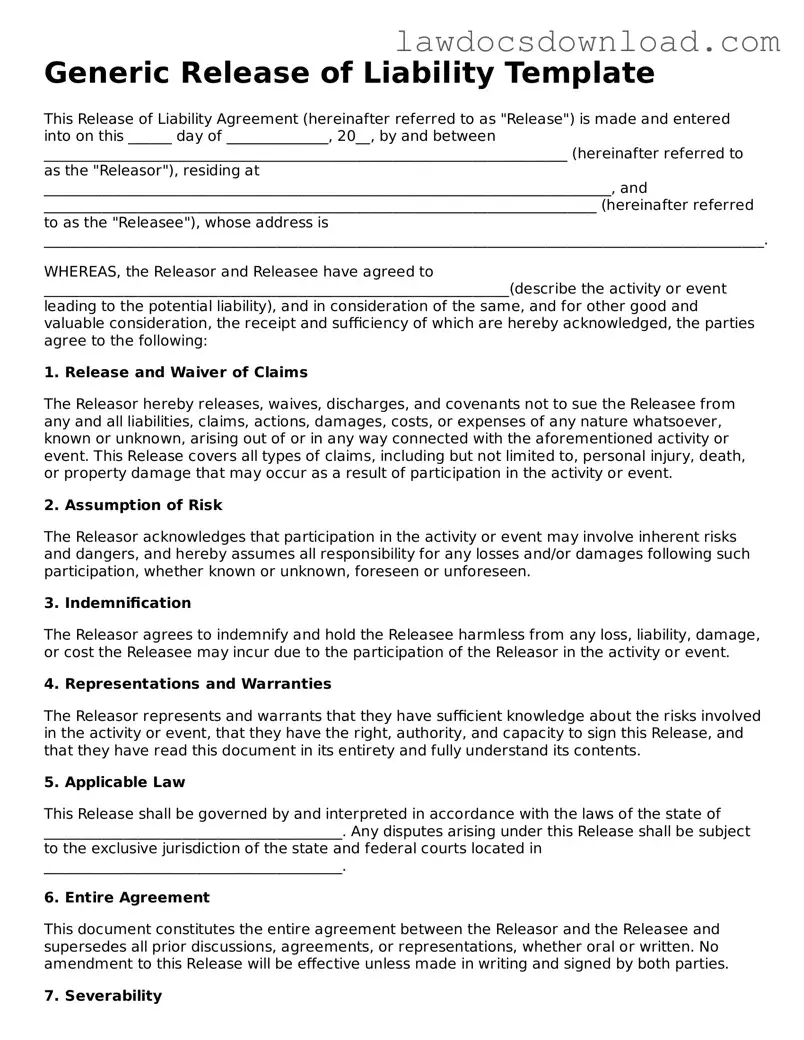Generic Release of Liability Template
This Release of Liability Agreement (hereinafter referred to as "Release") is made and entered into on this ______ day of ______________, 20__, by and between ________________________________________________________________________ (hereinafter referred to as the "Releasor"), residing at ______________________________________________________________________________, and ____________________________________________________________________________ (hereinafter referred to as the "Releasee"), whose address is ___________________________________________________________________________________________________.
WHEREAS, the Releasor and Releasee have agreed to ________________________________________________________________(describe the activity or event leading to the potential liability), and in consideration of the same, and for other good and valuable consideration, the receipt and sufficiency of which are hereby acknowledged, the parties agree to the following:
1. Release and Waiver of Claims
The Releasor hereby releases, waives, discharges, and covenants not to sue the Releasee from any and all liabilities, claims, actions, damages, costs, or expenses of any nature whatsoever, known or unknown, arising out of or in any way connected with the aforementioned activity or event. This Release covers all types of claims, including but not limited to, personal injury, death, or property damage that may occur as a result of participation in the activity or event.
2. Assumption of Risk
The Releasor acknowledges that participation in the activity or event may involve inherent risks and dangers, and hereby assumes all responsibility for any losses and/or damages following such participation, whether known or unknown, foreseen or unforeseen.
3. Indemnification
The Releasor agrees to indemnify and hold the Releasee harmless from any loss, liability, damage, or cost the Releasee may incur due to the participation of the Releasor in the activity or event.
4. Representations and Warranties
The Releasor represents and warrants that they have sufficient knowledge about the risks involved in the activity or event, that they have the right, authority, and capacity to sign this Release, and that they have read this document in its entirety and fully understand its contents.
5. Applicable Law
This Release shall be governed by and interpreted in accordance with the laws of the state of _________________________________________. Any disputes arising under this Release shall be subject to the exclusive jurisdiction of the state and federal courts located in _________________________________________.
6. Entire Agreement
This document constitutes the entire agreement between the Releasor and the Releasee and supersedes all prior discussions, agreements, or representations, whether oral or written. No amendment to this Release will be effective unless made in writing and signed by both parties.
7. Severability
If any provision of this Release is found to be unlawful, void, or for any reason unenforceable, then that provision shall be deemed severable from this Release and shall not affect the validity and enforceability of any remaining provisions.
IN WITNESS WHEREOF, the parties have executed this Release as of the date first above written.
Releasor's Signature: ___________________________________________ Date: _______________
Releasee's Signature: ___________________________________________ Date: _______________
Witness Signature: ___________________________________________ Date: _______________
